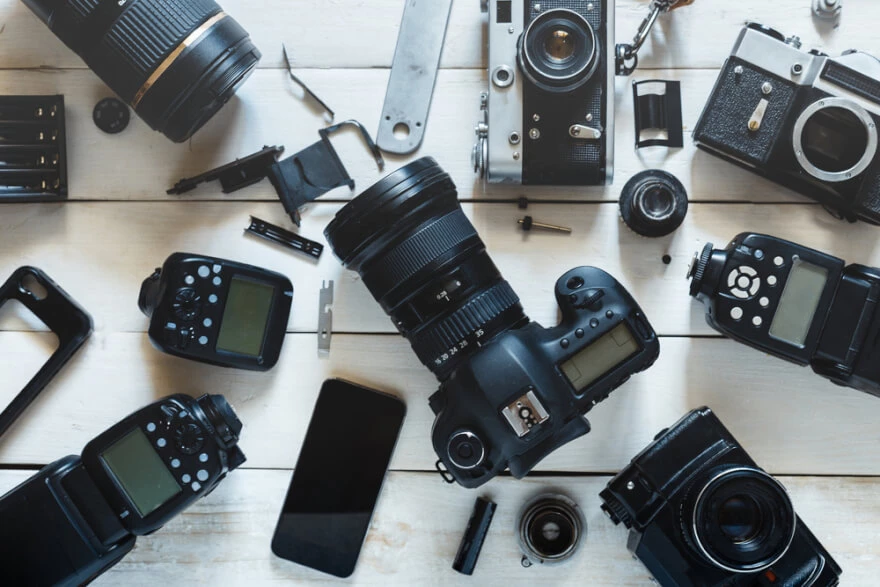DX vs FX format. What is better?

- 1. DX lens vs FX lens
- 2. DX vs FX format combination
- 3. FX vs DX dynamic comparison
- 4. Further DX vs FX lens advantages and disadvantages
Many of us have heard of a crop factor, DX vs FX cameras, but few understand what that means. In fact, there is nothing complicated about its difference. There is a misconception that using the same lens on FX and DX cameras, its focal length changes, and it must be multiplied or divided by a crop factor. Historically, 35mm film (more precisely, its dimensions are 24x36mm) has been and remains very popular. At the dawn of a digital age, Nikon wisely decided that it would be nice to make a digital camera so that you can screw on old optics that have been produced for decades.

The idea is good, but there were problems with implementation. It is too expensive to make a full-frame sensor, and it makes no sense to make a very small one. As a result, a “golden tool” was found. A sensor that was diagonally one and a half (1.5) times smaller than a 35mm film frame. 1.5 is the crop factor. By the way, Canon has found the optimal solution in the form of a crop factor of 1.6. Nikon's crop was named DX.
DX optics appeared because the sensor area was reduced by more than 2 times and it was possible to save on the production of expensive optics, thereby making DX technology available to amateurs.
Why is there such a great choice of sensors to compare? It's all about the price. Even now, in the “age of scientific and technological revolution”, production of an FX sensor costs about 20 times more than a DX. This is why FX cameras are so expensive.

But what, after all, do these sensors give us? In the case of Nikon, we get excellent compatibility with all Nikon lenses, save money, but what's the idea? The point is that a 35mm lens, for example, will have a narrower angle of view on a DX camera than on an FX camera. This is where the confusion arises for many. The angle of view on a DX camera narrows in such a way as if you were looking through a lens with a focal length of 1.5 times on an FX camera, that is, about 50mm. However, the focal length does not change! The viewing angle changes. That is, you need to cut out a piece of a picture from a 35mm frame. This will be what you see on a DX camera. And vice versa, if you are used to using a 50mm lens on a DX-camera, screwing it on the FX, the frame borders will move apart, and not the focal length will change. Changing the focal length is equivalent to zooming in/out of an object, but you won't find any of that.
The focal length confusion arises from the illusion of approaching. After all, the cut piece from a frame is stretched to fill the entire screen. This is analogous to “digital zoom”. It is like a comparison of a 10x15 photo printed from a 35mm image with a photo of the same size printed from DX images and it appears that objects are closer in the second print. Yes, they are closer, but not due to changing the focal length, but because a piece of a frame was cut out and stretched to a frame size of 35mm.

Why is such a reference so important? It is not the focal length that changes, but the angle of view? Focal length affects a lot of things. For example, changing the focal length changes the depth of field. None of this happens if you took the 50mm lens off the DX and put it on the FX. The depth of field remains the same. Also, changing the focal length will automatically change the composition of the frame.
A camera is a tool used to accumulate light. What's more, similar to any instrument, there are various cameras for various aims. The DSLR may be what could be compared to a pocket-sized multi-device, however, it isn't generally a correct camera for each activity. Proceeding with that manner of thinking, there isn't just a business opportunity for the DX sensor cameras, there are reasonable advantages and those fanatics of DX, which should be respected for their choice of a digital device and optics.
What is the use of the full-frame format and FX vs DX image quality level? Thanks to its large size, the sensor eliminates digital noise at high ISOs. If on a point-and-shoot camera the noise is visible at ISO more than 400, then on an FX-camera you can hardly see it at ISO 3200. In low light conditions, for example, indoors, this is critical and allows you to photograph without a flash.

1. DX lens vs FX lens
A circle full-frame lens onto a DX sensor will be trimmed by about a third. Such editing will give roughly a similar impact as when the picture is developed by one and a half times. This permits a 24mm lens on a DX design camera to have an edge of view identical to that of a 36mm lens on an FX camera. This effect is equivalent to as 1.5 crop factor. With this mix, the picture of a half format optics is smaller than the size of a full-frame sensor. Nikon full-frame cameras consequently make up for this impact by enacting just those pixels that coordinate the half-size sensor. This is called to edit DX automatically.
The difference between photos taken with a full-frame camera and a camera with a half-frame sensor can be seen uniquely in certain details, and an unpracticed beginner may not see it by any means. The principle of a full-frame optics is its size, not the quantity of pixels. Photosensitive components will take up more frames, bringing about a photograph with less clamor, and the capability of a focal point will be better demonstrated. Since better quality costs more, full-frame cameras and FX lenses are additionally more costly.

2. DX vs FX format combination
Both full and half format optics have central length markings on a zoom ring as though the camera was outfitted with a full-frame sensor. Owners of cameras with half perspective proportion need to calculate necessary incentive by a factor of 1.5 to figure the point of a picture and remember that wide-angle focal points lose their "wide edge" along these lines.
Most NIKKOR mirror optics can be utilized on full and half view cameras. On the off chance that you intend to change from a DX camera to a bigger full-frame option, you can keep on utilizing existing the NIKKOR half format lens. Full-frame DSLR will consequently address the smaller picture circle utilizing DX auto-crop. If you buy a full-frame lens for an FX camera, the focal point can, in any case, be connected to a DX camera and the picture will be amplified 1.5 times. FX vs DX DSLR permits you to choose distinctive picture areas in a Shooting menu. The quantity of various choices for the picture frame permits you to shoot in various picture editing modes.

3. FX vs DX dynamic comparison
- FX is bigger and better! This is true since more light falls on a larger matrix, it is possible to make each pixel very bold, which means it is better to convey halftones and color. In this case, diffraction occurs at a much higher aperture value. But is this necessary for an ordinary or even an advanced user? Everywhere and everywhere they shoot with simple DSLRs with a sensor size of 6*4 mm and get acceptable results. Manufacturers produce matrices with a huge number of megapixels, negating advantages of a large pixel, and besides, they put thick low-pass filters in front of a video matrix.
- FX has an excellent work at high ISO, while colors remain dense, and noise that appears is similar to film grain. This point is a bit controversial since it is due to the small number of megapixels in D700 and since matrices are constantly being improved, DX cameras are practically no longer inferior at high ISO.
- FX has a shallower depth of field and, accordingly, better background blur. This point can also be attributed to disadvantages under certain circumstances.
- Ability to blur the background with wide-angle optics when the subject is at a sufficient distance from you.
- Use of ultra-wide-angle optics, not available for DX.
- Designation of a focal length on a lens corresponds to normal. Unlike the popular opinion, the focal length of a lens is a constant value and does not depend on which frame is used, DX or FX. It does not matter on which frame you put the lens, its focal length distance always remains the same, but the size of photos and how it looks on a monitor depends on a specific size of a matrix. The image obtained from a crop matrix is just the central part of a frame from the full one. We can say that the size of the image obtained on a crop matrix with a lens with a 50mm lens will correspond to the size of 75 mm on your monitor in a full-frame. The only difference between a medium format, Nikon DX vs FX lens is its diameter and, accordingly, the diameter of the resulting spot (image) on a matrix.
- With the same number of megapixels, colors are denser due to a larger pixel size. Previously, Nikon DX vs FX cameras had the same number of megapixels. With the release of a D800, everything has changed and a pixel measure on the 16-megapixel D7000 corresponds to that of the D800. Probably, the D700 will remain in Nikon history as the camera with the largest pixel size and excellent ISO.

4. Further DX vs FX lens advantages and disadvantages
- FX has an excessively shallow depth of field (for example: shoot a portrait of 2, 3 people in 3/4, filling the whole frame with them. And if these people, moreover, are not strictly along the line, hold down the diaphragm up to 5.6 or even up to 8 so that both people are in sharpness. In low light, this is tantamount to a disaster, because the shutter speed is already long enough, and the sensitivity is already high. With DX, just move away at the same focal, and open up to 4 or 2.8. In this case, the ISO will end up in the same figure.
- Using only high-quality lenses. The image quality of a lens drops from the center to edges. When using full-frame lenses on a crop, only the central part of a lens is used and there is no noticeable drop in image quality from the center to the edge. This statement is true only up to a certain limit until the number of megapixels of a matrix does not exceed.
- Focal lengths of zoom lenses. Practically useless on a full-frame 24-70, turns into a universal 36-105 on crop and covers the entire demanded range.
- Focusing quality and speed. In the latest Nikon DX vs FX lenses the same focusing system as in full-frame models was used, but the same number of sensors falls on a smaller area of a frame, hence the focusing quality increases. Still, not everyone can understand the difference between NIKON 35mm 1.8 FX vs DX, it is worth trying.

FX lens is designed to properly project an image onto an FX sensor, 36mm x 24mm dimension. DX lens is designed to correctly project the image onto the DX sensor, for example, 18mm x 24mm or half the area of the FX sensor. Actual sensor sizes vary by manufacturer and even among sensors from the same manufacturer. A DX lens mounted on an FX body usually does not fully illuminate the FX sensor (it will usually provide at least vignette in corners). But even if it fully illuminates the larger sensor, it will not perform well at that large area, and results at edges can be expected to be poor and less bright.
If you are using an FX lens on a DX body, the middle half area of a lens will be used. This tends to have better performance, so using an FX lens with a DX sensor usually improves sharpness and contrast in detail. However, there are occasional reports that this FX lens performs less well with DX sensors. FX lenses generally have a specification that is heavier, larger, and substantially more expensive than a DX lens of the same specification. If you have a DX sensor system, you can get very little using an FX lens of the same specification, but the weight, cost, and size will be greater. If your goal is to impress with a telephoto optics and all the equipment, an FX lens might be better, but might not be worth the cost difference otherwise.

If you have a DX sensor system and buy FX lenses kit, they will work on an FX sensor if you upgrade it. BUT, if you buy DX lenses and upgrade, they will not fit the FX system. The partial exception is that some FX cameras take a DX lens and mask the outer half of a sensor area so that the lens and sensor act as if they were a complete DX system. A DX camera will shoot a smaller target area in a viewfinder than an FX camera with the same lens because the lens still projects the same image onto the sensor location in each case. DX sensor only calculates half of the projected area. Thus, 100% of the DX virtual sensor image consists of a smaller target area than 100% of an FX sensor image. This results in a typical APS crop factor usually, but not always = 1.5 for APSC cameras.
Considering the competitiveness of Canon and Nikon, other smaller manufacturers, like Sony, are also trying to gain a part of a market. Their options are more flexible in combination with DX and FX so that every newbie can try to become a PRO without any effort.
He started his career as a professional photo designer and retoucher. Professional commercial photographer with 20 years of experience. He is a leading advertising photographer and has worked as a food photographer with Michelin-starred chefs. His work with models can be seen on the calendars of many leading companies in Ukraine. He was the owner of the photo studio and photo school "Happy Duck".

with RetouchMe














